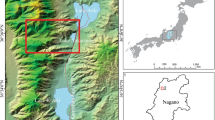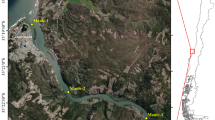Abstract
A comprehensive study (chronological, lithological and geochemical) of an 8.5 m postglacial sediment sequence from Lake Peipsi was conducted to elucidate the effects of lake-level changes on the sedimentary environment and biogeochemical dynamics in a large lake. Four lithological units were distinguished in the sediment sequence studied: clayey silt, slightly laminated greyish carbonaceous gyttja, brownish-grey gyttja and dark gyttja. These units indicate that large shifts in sedimentation processes occurred in the past. The sediment data show that fluctuations in water depth had a profound impact on the lake environment, recorded as changes in the lithological composition, phosphorus content of sediments and composition of diatom assemblages. The corresponding changes are best reflected in sediments accumulated during phases of regression when the lake area was also smaller. As the water depth and area of the lake increased, wave-induced erosion and resedimentation smoothed or even disturbed the initial information. The increase of phosphorus content in the unconsolidated, high-porosity surface sediments (0.5 m) is most probably connected with active diffusion and matter exchange between the water-sediment pools.



Similar content being viewed by others
References
Barker, P. A., N. Roberts, H. F. Lamb, S. van der Kaars & A. Benkaddour, 1994. Interpretation of Holocene lake-level changes from diatom assemblages in Lake Sidi Ali, Middle Atlas, Morocco. Journal of Paleolimnology 12: 223–234.
Battarbee, R. W., V. J. Jones, R. J. Flower, N. G. Cameron & H. Bennion, 2001. Diatoms. In Smol, J. P., H. J. B. Birks & W. M. Last (eds), Tracking Environmental Change Using Lake Sediments, Vol. 3: Terrestrial, Algal and Siliceous Indicators. Kluwer Academic Publishers, Dordrecht, 155–202.
Battarbee, R. W., N. Anderson, E. Jeppesen & P. Leavitt, 2005. Combining paleolimnological and limnological approaches in assessing lake ecosystem response to nutrient reduction. Freshwater Biology 50: 1772–1780.
Blinova, I., 2001. Riverine load into L. Peipsi. In Nõges, T. (ed.), Peipsi. Meteorology, Hydrology, Hydrochemistry. Sulemees Publishers, Tartu, 94–96.
Ciglenečki, I., M. Carić, F. Kršinić, D. Viličić & B. Ćosović, 2005. The extinction by sulphide – turnover and recovery of a naturally eutrophic, meromictic seawater lake. Journal of Marine Systems 56: 29–44.
Davydova, N., 1981. Diatoms in sediment cores from Lake Peipsi–Pskov. In Raukas, A. (ed.), Bottom Deposits of Lake Peipsi. Estonian Academy of Sciences, Tallinn, 74–81, (In Russian).
Davydova, N., 1985. Diatoms – Indicators of Natural Conditions of Water Reservoir in Holocene. Nauka, Leningrad, (In Russian).
Davydova, N. & K. Kimmel, 1991. Palaeogeography of Lake Peipsi on the basis of biostratigraphical studies of bottom sediments. Proceedings of the Estonian Academy of Sciences, Geology 40: 16–23, (In Russian).
Dean, W. E., 1999. The carbon cycle and biogeochemical dynamics in lake sediments. Journal of Paleolimnology 21: 375–393.
Golterman, H. L., 2004. The Chemistry of Phosphate and Nitrogen Compounds in Sediments. Kluwer Academic Publishers, Dordrecht/Boston/London.
Håkanson, L. & M. Jansson, 1983. Principles of Lake Sedimentology. Springer-Verlag, Berlin.
Hang, T. & A. Miidel, 1999a. Bedrock topography. In Miidel, A. & A. Raukas (eds), Lake Peipsi: Geology. Sulemees Publishers, Tallinn, 27–28.
Hang, T. & A. Miidel, 1999b. Holocene history of the lake. In Miidel, A. & A. Raukas (eds), Lake Peipsi: Geology. Sulemees Publishers, Tallinn, 131–135.
Hang, T., A. Miidel, V. Kalm & K. Kimmel, 2001. New data on the distribution and stratigraphy of the bottom deposits of Lake Peipsi. Proceedings of the Estonian Academy of Sciences, Geology 50: 233–253.
Heiri O., A. F. Lotter & M.-J. Lemcke, 2001. Loss on ignition as a method for estimating organic and carbonate content in sediments: reproducibility and comparability of results. Journal of Paleolimnology 25: 101–110.
Kangur, K., T. Möls, J. Haberman, K. Kangro, R. Laugaste, A. Milius, T. Nõges, H. Timm, T. Timm & P. Zingel, 2002. Lake Peipsi change of ecological state during 1992–2001. In Roose, A. (ed.), Estonian Environmental Monitoring 2001. Tartu, 57–64, (In Estonian).
Kangur, M., K. Kangur, R. Laugaste, J.-M. Punning & T. Möls, 2007. Combining limnological and palaeolimnological approaches in assessing degradation of Lake Pskov. Hydrobiologia 584: 121–132.
Kozerski H. P., H. Behrendt & J. Köhler, 1994. Possibilities and limitations of sediment traps to measure sedimentation and resuspension. Hydrobiologia 284: 93–100.
Kozerski H. P., H. Behrendt & J. Köhler, 1999. The N and P budget of the shallow, flushed lake Müggelsee: retention, external and internal load. Hydrobiologia 408/409: 159–166.
Krammer, K. & H. Lange-Bertalot, 1986–1991. Bacillariophyceae. In Susswasserflora Mitteleuropas 2/1–4. Stuttgart.
Miidel, A., T. Hang, R. Pirrus & A. Liiva, 1995. On the development of the southern part of Lake Peipsi in the Holocene. Proceedings of the Estonian Academy of Sciences, Geology 44: 33–44.
Niinemets, E., 1999. Ostracods. In Miidel, A. & A. Raukas (eds), Lake Peipsi: Geology. Sulemees Publishers, Tallinn, 90–97.
Nõges, T., A. Heinsalu, T. Alliksaar & P. Nõges, 2006. Paleolimnological assessment of eutrophication history of large transboundary Lake Peipsi, Estonia/Russia. Verhandlungen der Internationalen Vereinigung für Limnologie 29: 1135–1138.
Orviku, K., 1960. Geomorphology. In Orviku, K. (ed.), Geology of U.S.S.R., 28. Gosgeoltekhizdat, Moscow, 209–230, (In Russian).
Pirrus, R. & V. Tassa, 1981. On the sapropel layer at Värska. In Raukas, A. (ed.), Bottom Deposits of Pihkva-Peipsi Lake. Estonian Academy of Sciences, Tallinn: 82–93, (In Russian).
Punning, J.-M. & A. Leeben, 2003. A comparison of sediment and monitoring data: implications for paleomonitoring a small lake. Environmental Monitoring and Assessment 89: 1–13.
Punning, J.-M., M. Kangur, T. Koff & G. Possnert, 2003. Holocene lake-level changes and their reflection in the paleolimnological records of two lakes in northern Estonia. Journal of Paleolimnology 29: 167–178.
Punning, J.-M., L. Puusepp & T. Koff, 2004. Spatial variability of diatoms, subfossil macrophytes and OC/N values in surface sediments of Lake Väike Juusa (southern Estonia). Proceedings of the Estonian Academy of Sciences. Biology, Ecology 53: 147–160.
Punning, J.-M., T. Koff, E. Kadastik & A. Mikomägi, 2005. Holocene lake level fluctuations recorded in the sediment composition of Lake Juusa, southeastern Estonia. Journal of Paleolimnology 34: 377–390.
Raukas, A., 1981. On the lithological composition of bottom deposits in Pihkva-Peipsi Lake. In Raukas, A. (ed.), Bottom Deposits of Pihkva-Peipsi Lake. Estonian Academy of Sciences, Tallinn, 23–41, (In Russian).
Sarv, A. & E. Ilves, 1975. On Holocene deposits in the delta of River Emajõgi (Saviku). Proceedings of Estonian Academy of Sciences. Chemistry, Geology 24: 64–69, (In Russian).
SFS 3025: 1986. Determination of Phosphorus in Water. Finnish Standards Association SFS, Helsinki.
SFS 3026: 1986. Determination of Phosphate in Water. Finnish Standards Association SFS, Helsinki.
Simonsen, R., 1987. Atlas and Catalogue of the Diatom Types of Friederich Hustedt, Vol. I–III. Stuttgart.
Søndergaard, M., J. P. Jensen & E. Jeppesen, 2003. Role of sediment and internal loading of phosphorus in shallow lakes. Hydrobiologia 506/509: 135–145.
Yang, J.-R. & H. C. Duthie, 1995. Regression and weighted averaging models relating surficial sedimentary diatom assemblages to water depth in Lake Ontario. Journal of Great Lakes Research 21: 84–94.
Acknowledgements
The study was supported by the Estonian target financed project SF0280016s07 and the Estonian Science Foundation (grant no. 5370). This research was partly supported by the Estonian Environmental Investment Centre (contract no. 06-06-3/381). We thank our colleagues Jaanus Terasmaa for assistance in the fieldwork and Liisa Puusepp and Anna Ludikova for the help in compiling the diatom diagram. We thank the Estonian Border Guard for supporting field work in Lake Peipsi and Mrs Tiia Kaare for improving the language. The journal reviewers and the guest editor of the special issue are acknowledged for constructive comments.
Author information
Authors and Affiliations
Corresponding author
Additional information
Guest editors: T. Nõges, R. Eckmann, K. Kangur, P. Nõges, A. Reinart, G. Roll, H. Simola & M. Viljanen.
European Large Lakes—Ecosystem changes and their ecological and socioeconomic impacts.
Rights and permissions
About this article
Cite this article
Punning, JM., Kapanen, G., Hang, T. et al. Changes in the water level of Lake Peipsi and their reflection in a sediment core. Hydrobiologia 599, 97–104 (2008). https://doi.org/10.1007/s10750-007-9192-0
Published:
Issue Date:
DOI: https://doi.org/10.1007/s10750-007-9192-0




